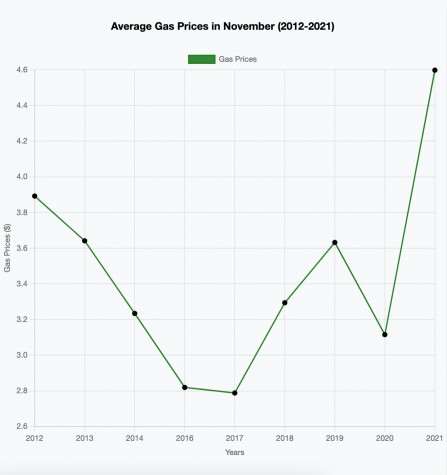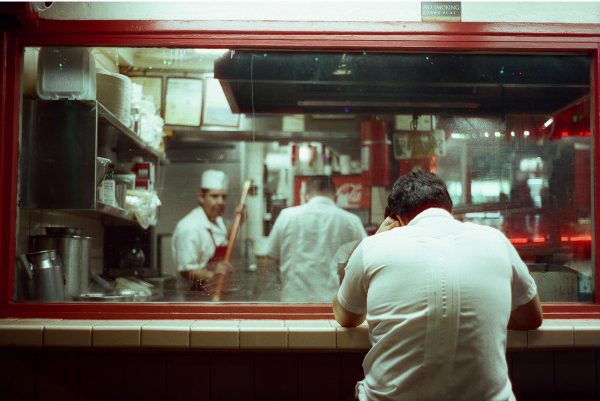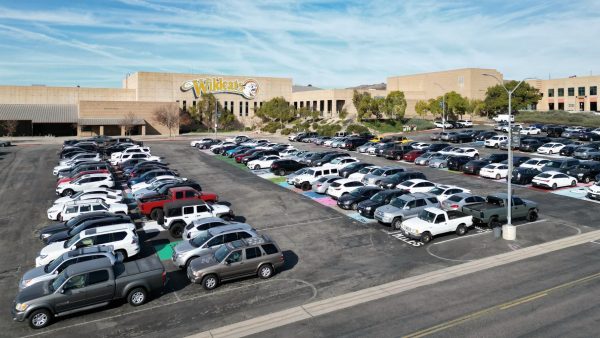Teen Drivers Hit Hard by Soaring Gas Prices

A steep increase in gas prices — as much as $4.66 for a gallon of regular at some stations in Brea — is putting a strain on student finances.
While fueling up her Ford Bronco, Diana Lee, junior, expected the traditionally long lines of road trip-ready vehicles during Thanksgiving vacation, but what she did not expect were the record high prices at the pump.
Gas prices usually fluctuate between two to three dollars, but this year, as COVID-19 restrictions eased for travel, and schools and businesses have reopened, the cost for gas rocketed from $3.262 in January to $4.598 in November, a 41% increase in just 11 months. And compounding the problem for BOHS students: California is the most expensive state for gas in the U.S.
Why are gas prices currently the highest ever for teen drivers? An increase in travel and commuters led to higher demand for gas. Because suppliers struggled to meet these demands due to the uptick in drivers, the cost to produce gas increased, and consequently, gas prices for consumers increased. “Demand has returned as the economy comes back and is outpacing supply,” Frank Macchiarola, of the American Petroleum Institute, posted on Twitter on Nov. 17.
The last time California saw such a drastic spike in gas prices was in October 2012, when a power outage struck Southern California, halting gas production for a week “in an already fragile and volatile market,” according to USA Today. Gas prices soared to $4.45 a gallon, but stabilized within a few weeks.

Unlike the brief surge in 2012, however, there’s no end in sight for the current wallet-busting prices, which have fluctuated by only $0.14 since May. “Inflation is on the rise all over, so I don’t think we are going to see gas prices go down the way it did in 2012,” Kate Caprine, economics teacher, said. “There will obviously be some fluctuations, but I think overall, gas prices are going to stay higher than they have been previously.”
Across Brea, gas prices are consistently high, ranging from $4.66 for regular at the West Lambert 76; to $4.45 at the Central Avenue Shell; to $4.33 at the Imperial Plaza ARCO. (Premium — or “91” — gas runs $0.30 to $0.40 more per gallon.)
The record high gas prices make affording fuel difficult for many BOHS drivers.
Talia Than, senior, uses the money she saved from her previous job to buy fuel. “Because I use my own money to pay for gas, I find myself being extra cautious and frugal when it comes to how much I spend,” Than said. “I try my best to limit the amount I use daily.”
“Since gas prices have risen, I’ve had to get a job,” Brooklyn Mercado, junior, said. Mercado disclosed that most of her money is used for gas.
Clara Lee, senior, describes the increase in gas prices as “frustrating,” especially because driving is essential for her busy schedule of extracurricular activities in Buena Park (for robotics) and Los Angeles (for an internship). “My car is pretty gas efficient, yet I use [the fuel] quickly due to the multiple cities I travel to daily,” Lee said.
Like Lee, Brooklyn Kame, junior, also drives to Los Angeles for an internship club. “Driving there and back uses up a chunk of my gas,” Kame said. Her depleted tank makes it challenging to also attend “basketball games and practices, school, [her] babysitting job, and hanging out with friends.”
To save money on gas, some students are carpooling with friends.
“If I do have to travel far, I try to hitch a ride with someone and always offer to pay for half of their gas if they need the gas money,” Mercado said. “I try not to go that far by myself because of the gas prices these days.”
Junior Catherine Chiu’s parents encourage her to carpool so that she doesn’t “have to waste any gas, especially now because gas prices are expensive.”
Other students are limiting their mileage.
Alyssa Felix, senior, spends almost $60 a week on gas, so she “tries to restrain from driving far distances as much as [she] can to try and save gas.”
“I’m more conscious about where I’m driving,” Chiu said. “If there’s a certain route that I know is going to use more gas, then I’ll find [another] way.”
Because gas prices are high and a number of students earn gas money from their parents, students have become more careful with how much gas they use to alleviate the burden on their families.
“I feel like I should not drive too far. I don’t want to [ask] my parents [for] too much money because gas prices are pretty high,” Curtis Ahn, senior, said.
“The increase of gas prices has caused my family to become more aware of how much we drive and spend on gas,” Nolan Nicassio, junior, acknowledged. “I try to save gas by [driving] less often, or carpooling.”
To combat the high gas prices, some student’s families have purchased electric cars.
Irene Kim, junior, bought an electric car “to make less trips to the gas station and to save money on gas.” Kim said, “Because I drive to and from school, internship, church, sports practice, and extra errands, being able to charge my car at home is less limiting [than having to buy] gas.”
Than’s family also invested in an electric car for her dad, who commutes to work in Los Angeles every day. “Having at least one electric car allows us to save on gas,” Than said.
Students may have to carpool, penny pinch, and avoid driving altogether for some time. “I don’t think [gas prices] will come down until after the holidays,” Caprine said. “People are always traveling during the holidays so [suppliers are] going to keep [fuel costs] up. Anytime people are traveling, the demand is higher, so the suppliers are going to want to have higher prices where they get more [profit] returned.”
Your donation supports the student journalists at Brea Olinda High School! The contribution will help us purchase equipment, upgrade technology, and cover our annual website hosting costs.

Jasmine Youn is a Wildcat Feature Editor, born and raised from the Bay Area in California. She likes to spend most of her time crocheting, listening to...

Karis Choi, junior, joined the Wildcat newspaper at the beginning of her sophomore year starting off as a photographer and staff writer and transitioning...
Kasia Alexander, freshman, is a photographer on the Wildcat. She enjoys baking, hanging out with friends and family, and dancing. One of the joys in her...
Alexis Alexander, senior, is one of the Photo Managers on the Wildcat. She has a strong passion for taking photos and telling stories through her pictures....








